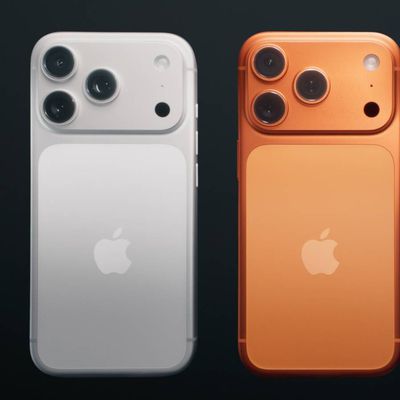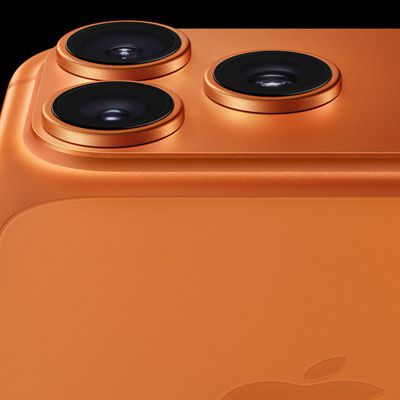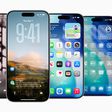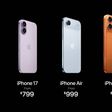Performance of Web Apps Saved to Home Screen Hampered in iOS 4.3
The Register reports that performance of web apps saved to the home screen on iOS devices running iOS 4.3 is significantly crippled compared to those loaded directly through the Safari browser for iOS, although it is unclear if the issue is caused by bugs or a conscious move by Apple to favor App Store apps over web app experiences.
If a web app is run from the iOS 4.3 home screen - in other words, if it is saved to the screen alongside local apps downloaded from the Apple App Store - it runs roughly two to two and a half times slower than it does in the browser, according to various tests. It appears that whereas Apple has updated the iOS 4.3 Safari browser with its high-speed Nitro JavaScript engine, Nitro is not used when web apps are launched from the home screen.
"Essentially, there are two different JavaScript engines," says Alex Kessinger, a mobile application developer and blogger who has focused on building web-standards-based apps for the iPhone. "They're not using the new JavaScript engine with applications that launch from the home screen."
In addition, web apps saved to the home screen are unable to take advantage of HTML5 web caching capabilities, preventing them from running while offline.
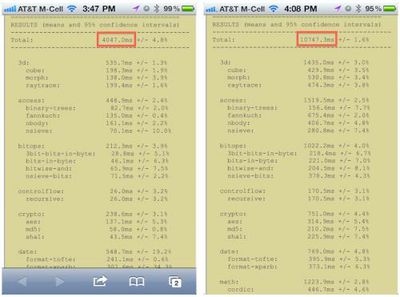 Sunspider loaded in Safari (left) and as home screen web app (right)
Sunspider loaded in Safari (left) and as home screen web app (right)One example given in the article is the Sunspider JavaScript benchmarking test, which was demonstrated running in 4047 ms when loaded within Safari but taking 10747 ms when loaded as a web app from the home screen.
The report notes that developers have filed multiple bug reports with Apple regarding the issues, with Apple apparently aware of at least some of the limitations currently being experienced with web apps saved to the home screen. Apple has reportedly acknowledged, however, that at least some of the issues, including ones related to the use of lower-quality synchronous mode rendering for home screen web apps as opposed to asynchronous mode used for content loaded directly in Safari, are not scheduled to be addressed by the company.
Popular Stories
Apple today introduced the iPhone 17 Pro and iPhone 17 Pro Max.
Both devices feature a new aluminum unibody design, with the Ceramic Shield now protecting both the front and back sides. Apple says the front side is now Ceramic Shield 2, which offers 3x better scratch resistance, while the rear Ceramic Shield is advertised as 4x more resistant to cracks compared to the back glass on previous...
Apple continues to phase out the physical SIM card tray on iPhones, with the latest models relying solely on eSIM technology in more countries.
The new iPhone 17, iPhone 17 Pro, and iPhone 17 Pro Max support eSIMs only in these countries and regions, according to Apple:
Bahrain
Canada
Guam
Japan
Kuwait
Mexico
Oman
Qatar
Saudi Arabia
United Arab Emirates
Un...
Apple's new Live Translation feature for AirPods will be off-limits to millions of European users when it arrives next week, with strict EU regulations likely holding back its rollout.
Apple says on its feature availability webpage that "Apple Intelligence: Live Translation with AirPods" won't be available if both the user is physically in the EU and their Apple Account region is in the EU....
Apple held its annual iPhone event on Tuesday, September 9, to unveil the iPhone 17, ultra-thin iPhone Air, iPhone 17 Pro, and iPhone 17 Pro Max.
All of the new iPhone models will be available to pre-order starting Friday, September 12 at 5 a.m. Pacific Time / 8 a.m. Eastern Time in the U.S. and dozens of other countries, according to Apple. The release date for the devices is one week...
While the iPhone 18 Pro and iPhone 18 Pro Max are still a year away, there are already a few rumors about the devices that offer an early look ahead.
If you are skipping the iPhone 17 Pro and want to know about what to expect from the iPhone 18 Pro models, we have recapped a few of the key rumors below.
Under-Screen Face ID
In April 2023, display industry analyst Ross Young shared a...
Apple has confirmed the battery capacities for the iPhone 17, iPhone Air, iPhone 17 Pro, and iPhone 17 Pro Max models that were announced earlier today.
Apple is required to publish energy labels on its iPhone product pages in the EU, and they reveal the official mAh battery capacities for the devices.
Here are the battery capacities for each model, according to Apple:
iPhone 17:...
The first benchmark results for the A19 Pro chip in the iPhone 17 Pro, iPhone 17 Pro Max, and iPhone Air surfaced in the Geekbench 6 database today.
Based on these early results — which are unconfirmed — the A19 Pro chip across the Pro models and the iPhone Air appears to deliver up to 13% to 15% faster multi-core CPU performance compared to the A18 Pro chip in the iPhone 16 Pro...



